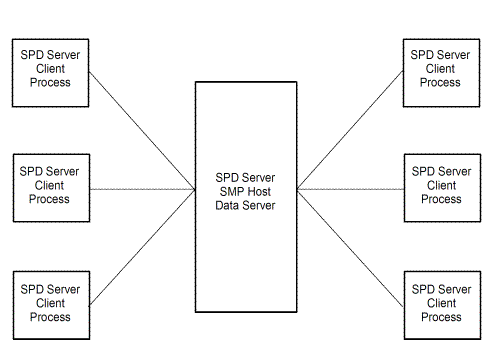The SPD Server Client/Server Model
Overview of the Client/Server Model
SPD Server software
divides SAS processing loads between the client and server. The The SPD Server Client/Server Model diagram shows a simple client/server topology. The server
hosts multiple concurrent clients while performing the heaviest processing
tasks. Typical clients are desktop PCs or low-end UNIX workstations
running front-end software. The front-end application sends the client's
data requests over the network to the server, and processes the information
that the server returns.
You can create one or
more SPD Servers on the host server machine. When an SPD Server host
receives a client's data request, it performs some action on behalf
of the client. The action varies with the request received.
Symmetric Multiprocessor Hosts
SPD Server host machines
use operating systems that can process concurrent threads in parallel
on multiple processors. SPD Server exploits symmetric multiprocessing
(SMP) hardware and software architecture.
The number of processors
on an SMP server varies by manufacturer and model. The operating system
of the machine must also support parallel processing. Operating systems
that have a threaded kernel enjoy enhanced performance because the
threaded kernel prevents contention issues among competing threads
in real time. Synergy between processors and threads allows SPD Server
to scale processing performance. The scalability, in turn, significantly
improves the speed of SPD Server table creates, appends, scans, queries,
and sorts.
SPD Server Host Services for Clients
-
Reduces network traffic SPD Server reads, sorts, and subsets entire SAS tables, and then returns answer sets. A query subset replaces large file downloads to the client machine. SPD Server offers a common storage facility. Multiple client users can use the same SAS data on the server without having to each transfer the SAS data to their workstations.
